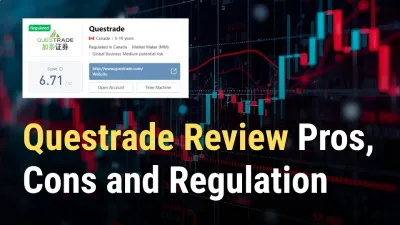简体中文
繁體中文
English
Pусский
日本語
ภาษาไทย
Tiếng Việt
Bahasa Indonesia
Español
हिन्दी
Filippiiniläinen
Français
Deutsch
Português
Türkçe
한국어
العربية
Forex Concepts That Always Make You Win
Abstract:Today In this article, we’ll cover the concepts of Support and Resistance, Entry and exit levels, and Trading with leverage and a system. Hopefully, these ideas will help you make money in forex. But before we get started, let’s look at some of the basics. Remember: the basics are the foundation of any successful trading strategy.

Today In this article, we‘ll cover the concepts of Support and Resistance, Entry and exit levels, and Trading with leverage and a system. Hopefully, these ideas will help you make money in forex. But before we get started, let’s look at some of the basics. Remember: the basics are the foundation of any successful trading strategy.
Support and Resistance
The main concept behind support and resistance is that price moves in opposite directions. A support level occurs when the price moves above it while a resistance level occurs when it goes below it. There are two ways to identify strong support and weak support level. The first method involves drawing a horizontal line through the previous high and low levels. The second method involves incorporating a higher time frame into your trading strategy.
Support and resistance levels are a vital part of forex trading. The concept tells you that a particular price will not fall below or exceed a certain level. Traders use these levels as “safe” zones and change strategy if price breaks below them.
Entry and exit levels
Many traders choose to enter and exit at the same levels on each trade. Its a matter of personal style, but eventually, you will find out what works best for you. In my case, I entered when the candle closed below the support line and exited when the candle closed above the support line and the price hit my exit target. Traders can set their own exit criteria, too. Some choose to exit at a certain amount per trade while others pick a certain amount of pips.
Whichever method you choose, its important to have a strategy. The best strategy involves analyzing past trades and comparing different entry levels. This way, you can avoid second-guessing your exit decisions. Using the right methodology and trading style will help you consistently perform in the market.
Trading with leverage
In the Forex market, leverage is used to increase the size of a position. A trader can use leverage up to 100 times their capital to increase their winnings. This type of trading is extremely risky, and it is important to assess your risk appetite before engaging in this type of trading. A high leverage ratio can be beneficial to an experienced professional, but new traders should stick to a lower leverage ratio to avoid losing money, but also to reduce the risks of getting stuck in a position.
Leverage allows traders to make larger profits on a trade, using their margin and controlled trading position. Because of the leverage, even a small change in price can bring substantial profits. However, it can also increase the losses a traders faces.
Trading with a system
Trading with a system is a systematic approach to trading, which involves following a defined set of rules. These rules determine which trades to make and when to make them, removing emotions from the equation. Most systems generate signals using technical indicators or a combination of them. Their primary purpose is to manage risk and maximize profitability in any market environment. They accomplish this by adjusting certain system parameters to achieve optimal levels of risk and reward. The first benefit of trading with a system is that it removes emotion from the trading process. Systematic traders will not make high-risk trades because they are frustrated, or because they are feeling rushed. This methodical approach results in a systematic trader reaping the rewards.
A trading system is a delicate construction. After it has proven itself to be profitable, you can make changes to the parameters of the strategy to maximize profits. Some of these adjustments include the reward-to-risk ratio, volatility, average drawdown, and average updraw.
Disclaimer:
The views in this article only represent the author's personal views, and do not constitute investment advice on this platform. This platform does not guarantee the accuracy, completeness and timeliness of the information in the article, and will not be liable for any loss caused by the use of or reliance on the information in the article.
Read more

Seaprimecapitals Withdrawal Problems: A Complete Guide to Risks and User Experiences
Worries about Seaprimecapitals withdrawal problems and possible Seaprimecapitals withdrawal delay are important for any trader. Being able to get your money quickly and reliably is the foundation of trust between a trader and their broker. When questions come up about this basic process, it's important to look into what's causing them. This guide will tackle these concerns head-on, giving you a clear, fact-based look at Seaprimecapitals' withdrawal processes, user experiences, and trading conditions. Most importantly, we'll connect these real-world issues to the single most important factor behind them: whether the broker is properly regulated. Understanding this connection is key to figuring out the real risk to your capital and making a smart decision.

iFX Brokers Review: Do Traders Face Withdrawal Issues, Deposit Credit Failures & Free Coupon Mess?
Have you had to pay several fees at iFX Brokers? Had your trading profit been transferred to a scamming website, causing you losses? Failed to receive withdrawals from your iFX Brokers trading account? Has your deposit failed to reflect in your trading account? Got deceived in the name of a free coupon? Did the broker officials not help you in resolving your queries? Your problems resonate with many of your fellow traders at iFX Brokers. In this iFX Brokers review article, we have explained these problems and attached traders’ screenshots. Read on!

NinjaTrader Exposed: Why Traders are Calling Out NinjaTrader’s Lifetime Plan & Chart Data
Did NinjaTrader onboard you in the name of the Lifetime Plan, but its ordinary customer service left you in a poor trading state? Do you witness price chart-related discrepancies on the NinjaTrader app? Did you have to go through numerous identity and address proof checks for account approval? These problems occupy much of the NinjaTrader review online. In this article, we have discussed these through complaint screenshots. Take a look!

Questrade Review Pros, Cons and Regulation
Is Questrade legit? Yes—CIRO regulated broker offering stocks, ETFs, forex, CFDs, bonds, and more with low fees and modern platforms.
WikiFX Broker
Latest News
Axi Review: A Data-Driven Analysis for Experienced Traders
INZO Regulation and Risk Assessment: A Data-Driven Analysis for Traders
GGCC Bonus and Promotions: A Data-Driven Analysis for Experienced Traders
Close Up With WikiFX —— Take A Close Look At Amillex
CapEx Spending On AI Is Masking Economic Weakness
Questrade Review Pros, Cons and Regulation
AccentForex Review: Is It Safe to Invest or Scam?
Cleveland Fed's Hammack supports keeping rates around current 'barely restrictive' level
Delayed September report shows U.S. added 119,000 jobs, more than expected; unemployment rate at 4.4%
The CMIA Capital Partners Scam That Cost a Remisier Almost Half a Million
Currency Calculator



